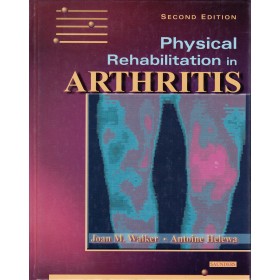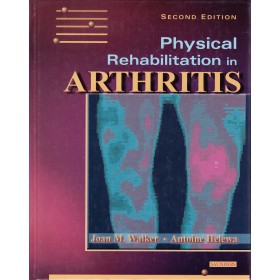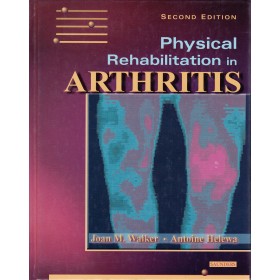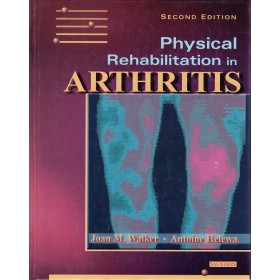Details
Share a Course: Physical Rehabilitation in Arthritis: Module 3 (Electronic Download)
SKU: 718SE
by Joan M. Walker, PhD, MA, Dip TP, BOT, Certifs in PT (NZ)
and Antoine Helewa, MSc (Clin Epid), PT
Do you already have access to the reading materials and only need the testing materials? Are you planning to Share A Course with someone else who already has the reading materials?
This course is offered in cooperation with Elsevier Science and utilizes the textbook “Physical Rehabilitation in Arthritis”c2004. This exciting book is devoted to the treatment of patients with arthritis and rheumatic diseases. Textbook discusses epidemiology, diagnostic information, pharmacology, surgical interventions, and management and rehabilitation issues. This course is essential to all therapists dealing with geriatrics!
Module 1 covers history of arthritis, epidemiology, pathophysiology, diagnosis and medical management of conditions with arthritis and assessment of joint disease
Module 2 covers pharmacology, surgical interventions, juvenile rheumatoid arthritis, rheumatoid arthritis and ankylosing spondylitis
Module 3 covers osteoarthritis, chronic muscle pain syndromes, patients with multiple joint involvement, splinting, orthotics, psychosocial factors, community-based physical rehabilitation and special topics in clinical research.
Order this product and it will be available to you immediately after purchase for electronic download in the “My Downloads” section of your account after you have logged in. The download files will require Adobe Acrobat Reader to open. If you do not have Adobe Acrobat installed, you may download it at no charge from Adobe.com.
Course Length: 7.0 contact hours
Instructional Level: Beginner/Intermediate
This package includes only the testing materials for Module 3 and not the required reading materials.
Physical Rehabilitation in Arthritis: Module 3
Course Goals:
This course is intended to instruct the student through self-paced study of the physical rehabilitation and treatment of patients with arthritic diseases.
Student Objectives:
At the end of this course the student will be able to:
1. Identify 5 elements of patient/client management leading to optimal outcomes as applied to patients with osteoarthritis.
2. Identify 5 areas of treatment implementations when treating a patient with osteoarthritis.
3. Identify 8 factors to consider in the use of thermal agents in osteoarthritis.
4. Identify the efficacy of treatment modalities as supported by current research for patients with osteoarthritis.
5. Identify components of a physical therapy protocol for a total hip arthroplasty and a total knee arthroplasty.
6. Identify chronic muscle pain syndrome.
7. Identify the clinical presentation of fibromyalgia and the criteria for the classification of fibromyalgia.
8. Identify the clinical presentation and diagnostic criteria for myofascial pain syndrome.
9. Identify the differences between fibromyalgia and myofascial pain syndrome.
10. Identify treatment strategies for patients with fibromyalgia and myofascial pain syndrome
11. Identify risks of inactivity.
12. Identify 5 components of physical fitness that a comprehensive exercise evaluation should consider.
13. Identify risk factors and recommendations for exercise-testing and participation
14. Identify the 3 components of a comprehensive fitness program
15. Identify arthritis-related considerations when designing an exercise program for an arthritic patient.
16. Identify specific considerations for aerobic exercise in patients with osteoarthritis, rheumatoid arthritis, anhkylosing spondylitis, psoriatic arthritis, systemic lupus erythematosus, and fibromyalgia.
17. Identify 10 purposes of splints and orthotics when treating clients with arthritis and other rheumatic diseases.
18. Identify 3 categories of hand splints.
19. Identify purposes of and splinting positions for resting hand splints, wrist cock-up splints, thumb splints and finger splints.
20. Identify 6 examples of foot disorders that may develop in clients with arthritis.
21. Identify 10 signs that should be visually inspected during a foot evaluation for a client with arthritis.
22. Identify footwear considerations for a client with arthritis.
23. Identify common assistive devices for self-care, meal preparation, home maintenance, work and school and leisure activities.
24. Identify common daily energy conservation strategies for the arthritic patient.
25. Identify 8 key principles of joint protection.
26. Identify the prevalence of depression in patients with arthritis.
27. Identify common characteristics, somatic complaints and signs and symptoms of depression.
28. Identify the difference between active and passive coping strategies and identify examples of each.
29. Identify 2 types of interventions for clients who have arthritis and are depressed.
30. Identify 5 advantages of home assessments with patients who have arthritis.
31. Identify the importance of specific treatment goals and plans when performing home care visits.
32. Identify advantages the home care therapist has over the outpatient therapist when treating patients.
33. Identify treatment modalities that can be performed at home and identify examples of each.
34. Identify 3 types of exercises that should be included in a home therapeutic exercise program.
35. Identify common problems seen in the home setting with patients who use adaptive equipment and ambulation aids.
36. Identify the importance of utilization of community based programs when available to patients.
37. Identify the importance of effective and ongoing discharge planning when performing home care therapy.
38. Identify the abundance of lack of abundance in research studies involving the effect of physical rehabilitation on patients with arthritis.
39. Identify the difference between a null hypothesis and an alternate hypothesis.
40. Identify the difference between statistical significance and clinical importance.
41. Identify characteristics, advantages and disadvantages of health status instruments (HSIs).
42. Identify the difference between measurement precision and accuracy



















